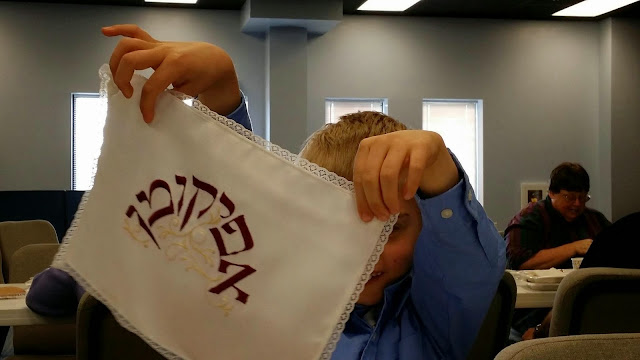Temple Teshuvah which meets Saturday at 11AM in the Jubilee worship center in St. Cloud hosted a Passover Seder. They are a Messianic Temple. Which means that they recognize Jesus as Savior. Every time that I go to a Passover Seder, I learn something new. So instead of telling you every detail of the Seder, I am going to share with you what I learned new. Seder means "order" so it is the Passover Order (of service).
 |
| Table Setting |
The first thing that I noticed was that they used romaine lettuce. Which I thought was a bit strange until I saw how they used it (you will see that later). I didn't take a photo but as a part of the Seder Psalms 24:3-4 instructs "Who may go up the mountain of Adonai? Who can stand in his holy place? Those with clean hands and pure hearts. . ." So there is a hand washing section of the Seder. They used a water picture and basin similar to the old fashioned washing stations that would be in a bedroom (before the times of running water in the house.) One person walked around the table and ceremonially washed hands. Then they switched places with someone else so their hands could be washed.
 |
| Unleavened Bread |
Instead of using store purchased matzah, they had homemade unleavened bread. It did not have the symbolic stripes and piercings but it was more like what would have been eaten in the dessert by the Jews that were freed from Egypt.
 - - |
| Eating Parsley dipped in water |
I sat across from this very well mannered young Jewish boy. The bitter herb (parsley) dipped in salt water is supposed to be something difficult to eat but he enjoyed it with all his heart. It reminded me of my nephews drinking pickle juice.
 |
| Matzah with maror and kharoset |
"We dip the bitter herbs into kharoset to remind ourselves that even the most bitter of circumstances can be sweetened by the hope we have in God." Kharoset is made from chopped apples, honey, nuts and wine (or grape juice) and the bitter herb in this case is horseradish. If you have ever eaten horseradish, you know that it can bring tears to your eyes. But when eaten in a bite with kharoset and matzah, the bitterness changes into a flavor that dances on the pallet. It is the same when we add God into our difficult situations in life, he can make our hearts joyful.
 |
| "Jewish Taco" |
Lettuce is also a bitter herb. They had us put kharoset and horseradish inside the romaine lettuce leaf. The Rabbi referred to it as a Jewish taco: bitter that is overcome by sweetness.
 |
| A child's search for the Afikomen |
In the middle of the service, the Matzah is "broken" and half is hidden which is a symbolism of Jesus death and time in the tomb. Towards the end of the service, the children look for the Afikomen which is then used as the Body of Christ for communion. It struck me as amazing that with the excitement and love of a child the Body of Christ is removed from hiding and brought forth for communion.
Matthew 18:3
New International Version (NIV)
3 And he said: “Truly I tell you, unless you change and become like little children, you will never enter the kingdom of heaven.
http://www.biblegateway.com/passage/?search=Matthew+18%3A3&version=NIV


 -
-












No comments:
Post a Comment